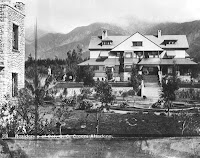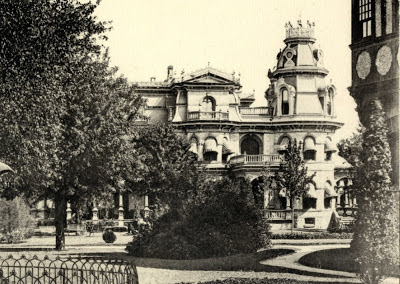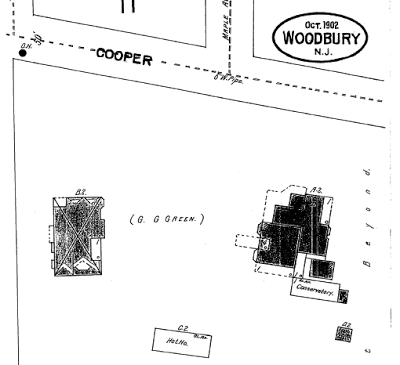Once upon a time, Green provided jobs to as many as 600 locals between his two glass factories and patent medicine laboratory alone (Pepper, 1971). In 1888, as president of the Board of Trade, Green successfully attempted to invite new industry to Woodbury by convincing Council to waive local taxes for five years for new industries (Woodbury, 1988). The general local impression of the Green family was one of favorable disposition judging from the many editorials published in the Woodbury Daily Times, Woodbury Constitution, and other local newspapers of the time. It was written in 1925 that his "success in business seemed to intensify his desire to advance the interests of the town of his choice. Very few men succeed as Col. Green has succeeded. Few would have remained to live in a town which was at that time only a little country village. But he had a vision of a great future for Woodbury and made that vision practical by casting his lot here permanently." Even down to Green's residence, the palace of Gray Towers itself was viewed as a source of pride to Woodbury and symbolically represented the "result of true merit;" G. G. Green's very words.
At one point, G. G. owned 3 (excluding his other real estate holdings) extravagant residences: Gray Towers, Kil Kare Castle in Lake Hopatcong, NJ, and an Arts and Crafts style mansion in Altadena, CA; a town in which he helped build. However, it was Gray Towers in Woodbury that he truly called home and on February 21st, 1925 G. G. Green joined the heavenly choir and died within his blue stone mansion on Cooper Street. "Unlike many a man of wealth remembered only for profligate eccentricities or penny-pinching exploitation, Green was an innovator who transformed and benefitted communities and industries that came within his orbit." (Pepper, 1971) He was buried at the Eglington Cemetery at nearby Clarksboro, NJ.
 |
| G.G. Green in Gray Towers Woodbury, NJ photo credit: Lake Hopatcong Historical Museum |
 |
| Kil Kare Castle on Mount Harry Lake Hopatcong, NJ |
 |
| G. G. Green Mansion Altadena, CA |
G. G.'s widow, Angie Brown Green remained at the residence until her death in 1934. Afterwards, the mansion remained in the family in an uninhabited state until August 1943 when the St. Patrick's Parish under Rev. James McKeever purchased the building for potential use as a parochial grade school (which became the St. Patrick's School). Adaptive reuse was virtually unheard of in 1943 and we should applaud the parish at that time for an early attempt at reusing a grand Victorian mansion for a use other than what it was designed for. However, the historic preservationist in me can't help but feel shocked at what resulted architecturally in creating a parochial school out of a grand second empire mansion. But let's face it, they purchased a historic building that was not protected during a time when Victorian architecture was viewed as pompous and over-ornate. It seems that the 1940's were hard on Woodbury Victorians as that is when the city also lost the equally magnificent Lewis M. Green mansion (Woodbury's mayor 5 times over) on Broad Street. It wasn't until the 1970's when things nationally began to turn in favor of saving historic buildings and not until the 1980's when the protective historic districts were setup in Woodbury. I might add that still we must see historic structures torn down without much of a fight.
How I wish that someone in the city in 1943 had the forethought to recognize the massive potential for Woodbury in purchasing and restoring Gray Towers as a tourist attraction or museum in honor of the single most important family in Woodbury history, save the Woods themselves.
But that never happened. Instead, the third and fourth story ornate and rare S-curved mansard roof, towers, and wraparound porches were torn off, effectively changing Gray Towers into a gray stone box. Further architecturally bland box additions were added to the building in 1953 and 1961; a classic "remuddling." Mouse over the below image for a dramatic before and after of the West side entry.
 |
| place your mouse over the image above to see the dramatic "remuddling" of the West side of Gray Towers in the 1940s or see below: |
G. G. Green Jr. himself remarked that it was like, "going into another world" and on a return visit, Robert Luba with Blanche and Gay Green remarked that, "The mansion and grounds which were once beautiful are now in terrible shape. It was a shame to see how beautiful they were and how rundown they are now." But at least the core of the building still stood for a time, allowing for a hint at its former glory. That all changed however, on May 21st 1968, when a 3-hour blaze fought by over 100 firefighters left the mansion "in ruins."
 |
| Catholic Star Herald May 31, 1968 |
The End.
 |
| Carriage House and Coachmen's Residence w/Gray Towers in Background This thankfully still stands and Holy Angels Parish is currently fixing the exterior! |
The below image is a 2012 aerial map image with a 1930 B&W aerial inset of Gray Towers showing approximate location of where the mansion sat. The Gray Towers' stable house (still standing) is shown just left of the inset box, the old Woodbury Station is shown upper left corner at the intersection of Cooper and Railroad.
 |
| 1902 Sanborn map showing carriage house on left and Gray Towers on right. |
Carter, B. F., Carpenter, J. D., & Stewart, F. H. (1938). History of Woodbury, New Jersey, from 1681 to 1936. [Woodbury, N.J.: Gloucester County Pub. Co.]
Col. G. G. Green passes away. (1925, Feb 26). Gloucester county democrat
Green mansion purchased by St. Patrick's parish as site of parochial school. (1943, Sept 9). Gloucester county times
McAlester, V., & McAlester, L. (1984). A field guide to American houses. (p. 251). New York, NY: Knopf.
Pepper, A. (1971). The glass gaffers of New Jersey. (p. 194). New York, NY: Charles Scribner's Sons.
3-hr. blaze damages St. Patrick's school; all classes called off. (1968, May 22). Gloucester county times
Woodbury Multiple Resource Area: Partial Inventory of Historical and Architectural Resources, nomination document, 1988, National Park Service, National Register of Historic Places, Washington, D.C.











4 comments:
This is a very well put together blog and very informative, makes me miss Woodbury!! I'm so happy to see that it is an area of interest for many. Thanks for sharing!
I use to attend St. Patrick's School in the 1980's...never knew of the rich history of the land that I was educated and played on! Thanks. Post more pictures!
I went to school in the old mansion before my family moved to Indiana in 1961, when I was in 5th Grade. I did not know the story until now. Thanks.
I wonder if I was in your class, John.
I attended St. Patrick's Elementary School from Kindergarten to 8th grade - from 1956-1965. We had Miss Corcoran in that huge first floor Kindergarten classroom in the beautiful old mansion. I remember the amazing curved staircase that wound up to the "higher grades" when I was in Kindergarten. I also had Sister John Dominic in 6th grade in the front room of the mansion downstairs. What an amazing history it had - such beautiful photos. Thank you for all the work put into the development of this informative site. Mary Ann
Post a Comment